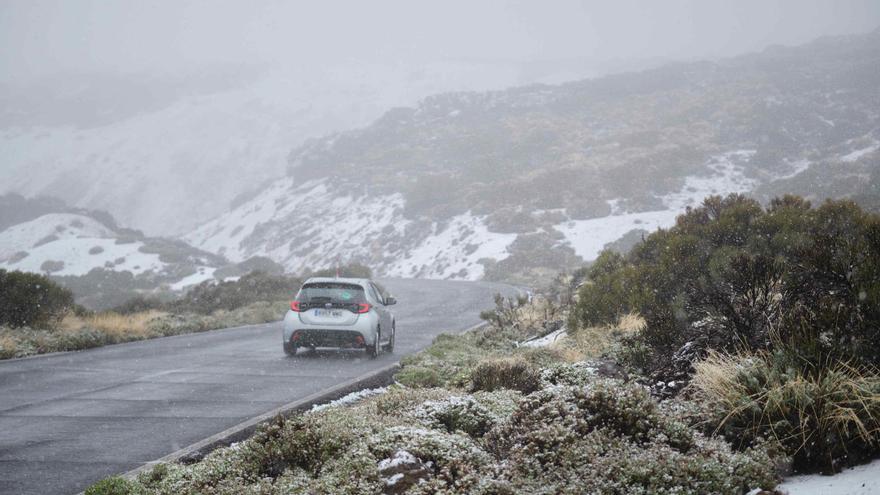
The spring rains have not alleviated the drought emergency declared in the Tenerife countryside. The 80,000 cubic meters recorded during the passage of the DANA last weekend have barely increased by 2% compared to the data from seven days earlier. “Not very relevant” according to the Minister of the Agricultural Sector of the Council, Valentín González, who points out, “it is worth remembering that Balten has a capacity in its 23 reservoirs of 4.8 million cubic meters.” González Évora assesses: “This increase really occurs because the demand is lower, not because rainwater is being added to the reservoirs.” He points out that between the 1st and the 25th of last month (the last available figure), “the difference in storage is 5% when going from 40.5% to 45.6%.” In this latter case, there were 1,608,495 cubic meters filled compared to the total of 4,836,664.
“There has been no increase in the water reserves of the Balten Reservoirs,” adds the minister, “since in the current hydrological year (which started in October 2023 and ends in September 2024) there have been no excess water resources produced, nor has the storage level necessary to face the 2024 season with supply guarantees been recovered.” Hence, emphasizes, “the extraordinary measure of declaring a water emergency due to adverse agroclimatic reasons.”
Trend
[–>
In the last 4 years (2020-2023), warm thermal anomalies and a deficit of precipitation have been the usual trend on the island, as summarised by González. Eight heatwaves have been recorded, along with numerous episodes of high temperatures, some occurring outside the summer season. Additionally, the number of hours of sunlight has been more than 10% above normal from a climatological perspective. There has been an increase in the average air temperature of over 0.5°C, with a higher increase in the midlands of approximately 1°C. Furthermore, the area minister continues, “last January, the average air temperature in Tenerife was 3.2°C higher than the normal for the first month of the year.”
Demand
[–>
Another key factor is that the demand for irrigation water has significantly increased, with 18% more volume supplied in the first half of 2023 compared to the same period in the previous year. One way to address this situation is by adding new resources to the system sustainably, either through desalination or purification for subsequent agricultural use (reclaimed water), while simultaneously working on reducing losses in municipal supply networks and promoting resource optimization through all possible means.
Consumption
[–>
Tenerife consumes 200 cubic hectometres of water per year, with 87 going to agriculture, 71 to urban consumption, and 21 to the tourism sector. Additionally, small amounts are lost in conduits, drains, and unutilised flows. The annual production offer amounts to 198 cubic hectometres and the demand to 197.2; meaning that the figures are very close. The Insular Water Council points out, through its manager, Javier Davara, that the first step is to “accurately measure the drought”, and then the option is to “regulate demand” because the supply “will remain more or less the same.”
Regarding the recent rainfall, Davara insists that “the first step is to define the indicators that allow us to measure the declaration of the emergency because this is the first time this measure has been taken.” He anticipates that the levels of the network of the 23 Balten reservoirs and the main municipal reservoirs in the largest municipalities will be the key indicators. In both cases, he states, “we have already requested reports to assess the situation and decide on the parameters to establish and maintain for the six months, extendable, allowed by the Water Law; the conditions based on the existing reserves.” He agrees with the insular minister of the Agricultural Sector that “the recent rains have allowed farmers not to irrigate that day, and the planned water from desalination or purification plants is not consumed.” For comparison: “If it was 80,000 cubic meters, only the Mountain Reservoir of Taco in Buevnavista-Los Silos can store 900,000.” He concludes: “It is very little and by no means enough to solve the situation.”
Tourism
[–>
“The water scarcity is not the hotels’ fault.” This statement was made by Lope Afonso, Vice President of the Council and Tourism Minister on Wednesday. He added, “The consumption has not increased there. The problem is essentially the continuous drought.” He emphasized that “many hotels have their own desalination plants and advocate for responsible consumption.” He pinpointed the issue on “the drought and leaks in municipal networks.” Hence, the water emergency has been declared to plan actions due to the expectation of a “very challenging summer.” He noted that “tourist consumption is lower” because “there are fewer tourist beds since the pandemic.”
Strategy
[–>
The Tenerife Council has been designing a strategy for years to increase water efficiency in agriculture. This is done through the Insular Irrigator Office located within the La Quinta experimental farm in Garachico. Several projects on cultivation, practices, and training courses are carried out there. From evaluating facilities to irrigation management and recommendations provided to farmers, including research lines on adaptation to climate change and automation. The Irrigator Office analyses the irrigation water consumption to reduce its impact. So far, it has studied installations on 400 hectares with 470 delimited sectors in 65 farms. Another way to combat the island’s drought.















